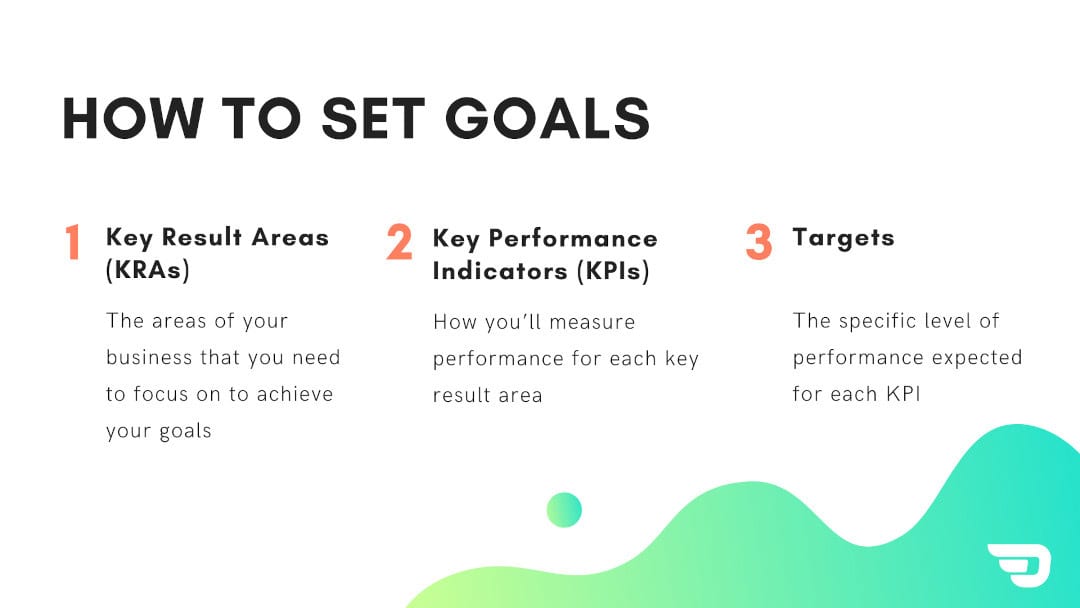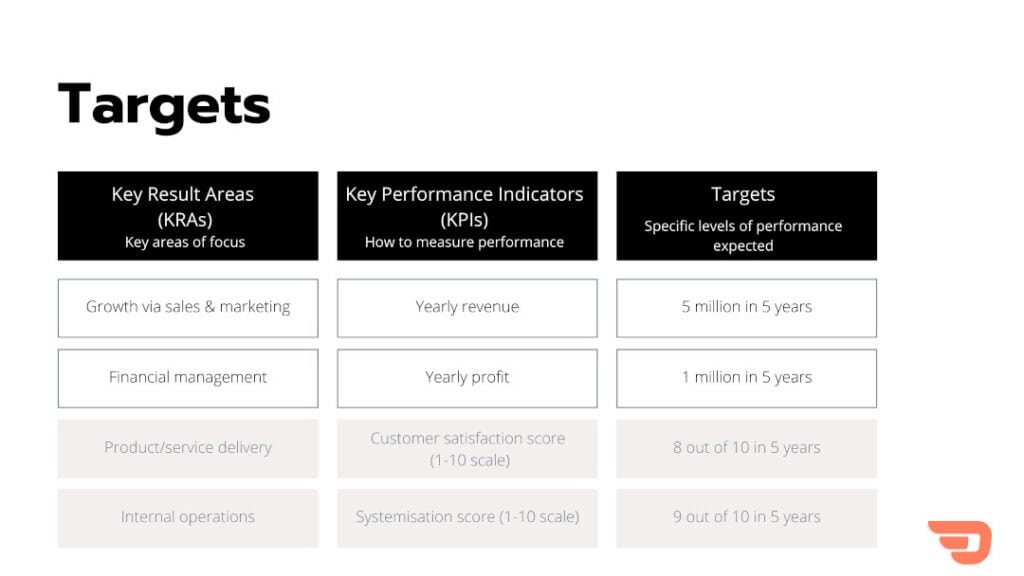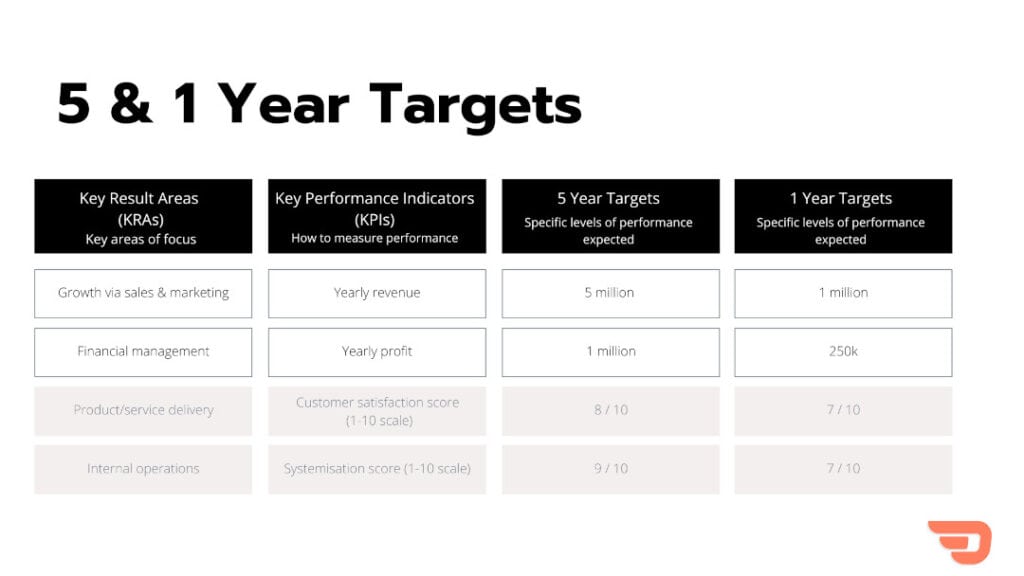
Goal Setting For Ecommerce Businesses: KRAs, KPIs, and Targets
It’s always surprising how many ecommerce business owners are “winging it”.
The fact is, high performing operators don’t wing it. They set goals. They set KPIs. They set targets. And then they aggressively go after those targets with a plan and a lot of action.
That’s what this video is about. It’s about why every business owner needs to set goals, define their Key Results Areas (KRAs), Key Performance Indicators (KPIs), and high-level targets.
This is the first module of our eCommerce Growth Engine Course on how to drive more traffic conversions and profit from your eCommerce business. To access the full course, click here.
Table of Contents
Goal Setting for Ecommerce Businesses and Why It’s So Important
The very first step on your growth journey is goal setting. Goals are the specific measurable results that you aim to achieve in your business. Goals and the metrics you track to get there are incredibly important.
Consider flight pilots, they start with a high-level goal, for example, to arrive at a particular destination by a designated time. But they don’t begin flying and hope for the best. Despite significant flight training, pilots have a complex computer system located on the cockpit’s dashboard to constantly track the plane’s performance. And the system focuses on a few key indicators like its altitude, flight path, g-force, speed and so on. Each of these indicators has an optimal level, a goal if you like, to aim for that helps them assess how the plane is performing. If any of the indicators move too far from the optimum state, a warning is given enabling the pilot to correct it immediately, or seek help. Goals are your version of the pilot’s dashboard indicators and they’re just as critical for a business as they are for a plane.
Why?
First of all, goals help you assess and improve your performance. In a similar way to pilots, goals provide benchmarks against which you can assess the performance of your business as it progresses along its growth path. When you can see clearly and objectively how you’re performing compared to a goal, you’re much more likely to achieve that goal.
Of course, that shouldn’t be surprising, right? To use a different analogy, imagine an archer who never saw where their arrow landed… it would be impossible to improve over time. Without some way of measuring the success of their attempts, how could they ever know how to correct their approach for next time?
Goals also serve a psychological purpose. They provide specific, tangible benchmarks for you to achieve, which increases the ongoing focus and motivation to push through challenges. And that’s why the most effective business owners set goals like:
- Yearly revenue
- Profit goals
- An ideal customer satisfaction score
- A cash flow budget
- Production quality standards
You get the idea. And then they track their progress against those goals to ensure they’re on track.
The 3 Critical Components of Setting Goals For Your Business

Effective goals have three critical components.
Number one is what’s called Key Result Areas, or KRAs. These are the key areas of your business that you’ll need to focus on to move from your current state to your long-term goals.
Number two are what are called Key Performance Indicators, or KPIs. They’re all about how you’ll measure performance for each key result area.
And finally, you’ve got targets. Targets are the specific level of performance expected for each KPI.
Let’s look at each of these in detail and make it practical for you. So we said that goals help to measure and improve performance, but performance in which areas?
Your Key Results Areas (KRAs)
To answer that question, you’ll first need to define your KRAs and your Key Result Areas. These are the key areas of your business that you need to focus on to move from your current state to your long-term goals. If you don’t make deliberate strategic decisions about where to focus your efforts, you’ll end up with random goals that might not drive the results you’re after. A business can have a number of different KRAs. And you’ll see in the table here there are some common examples. Let’s run through them briefly.

When business owners think about which areas of their business they want to focus on, often the first area that comes to mind is growth via sales and marketing. That’s of course an important goal because it ultimately leads to more revenue. And that’s one of the primary goals that we are going to be focusing on in this course.
But it’s not enough to merely generate revenue. You also want profit, and you might want consistent cash flow in order to stay afloat, and for that, you’re going to need effective financial management. So that is an area that we’re also going to be exploring together in this programme.
The next two areas that you can see on this diagram here, are domains that we won’t be focusing on in this course, and hence, they’re greyed out here, because they’re not about growing your business, they’re about the operational side of your business and the delivery of your products.
But I do have them here because I want to send the message that it is worth thinking about them. For example, to achieve the financial success you obviously need to deliver great products or services. Now, if you can’t do that you won’t actually achieve your financial goals. And finally, to deliver great products or services, and thereby achieve your financial and growth goals, you’ll also need your backend people and systems to be working smoothly and efficiently. Again, these last two areas are there for completeness because they are important for your business, but we won’t be focusing on them in this course.
Your Key Performance Indicators (KRAs)
Once you’ve identified your KRAs, the next step is to decide how you are going to measure performance for each area, that is your KPIs, your Key Performance Indicators.
For example, if one KRA is growth, then your yearly revenue is a common way to measure that growth. It’s not the only way, but it’s probably the easiest way to track and the most common way of measuring it. Alternatively, if your KRA is financial management, then yearly profit is a common way of measuring that, as you can see in the table.
Your Top Level Targets
KPIs tell you how to measure performance, but they don’t tell you the exact level of performance expected. That’s why you’ll need specific tangible, time-based targets for each KPI. So for example, if yearly revenue is your KPI, then your target might be $5 million of revenue within five years, right? In addition, your target for profit, for example, might be $1 million in profit per year in five years’ time.
It’s critical to set both short-term and long-term goals. That way if you haven’t reached your short-term objectives, you’ll be able to take corrective action to get back on track toward your longer-term goals. And that’s why we’re going to suggest that you set five-year targets and one-year targets.

As you can see in the example for yearly revenue, your five-year target could be 5 million per year in revenue, and your one-year target could be achieving $1 million per year in revenue. And same with profit – you can see your five-year profit target might be achieving $1 million of profit per year in five years, and 250K within the first year.
One final point
Before you start setting your own targets, keep in mind that your targets should be both challenging and achievable. Accomplishing the target should require significant effort. Yet you should also expect that you can actually accomplish it – otherwise you risk demoralising yourself and your people, as you fall short of your goals. Now you understand the components of effective goal setting, it’s time to set them for your business.
Your Next Steps
There are three basic steps that you can record in your eCommerce Growth Plan Template.
- Set your KPIs. This is where you’re going to decide how you’re going to measure progress for each key result area, by identifying those Key Performance Indicators.
- Next, you set your five-year targets for each KPI. What do you want to achieve in five years’ time?
- And then finally for each KPI, set a target for the coming year, ideally one that will set you on your path towards your five-year targets.
A final word: some people find this task of setting goals easy. You know where you are now, and you know where you want to be and if that’s you, fantastic. But some people need to gain a bit of a deeper sense of where they are right now to be able to set goals for the future.
If that sounds like you, I’m going to suggest you go to the next part of this module called Current Reality and see if you can complete that. Because that will give you a sense of your current situation and then come back to the goal setting once you have a clearer sense of where you are now. Either way, good luck with your goal setting, it’s the first critical step in your growth journey.
Access the Full Ecommerce Growth Engine Course for Free
We really hope you enjoyed this training video. If you did, and you’d like to access the full eCommerce growth engine course click here.
Need Help?
If you need help finding your target market and building a cohesive marketing strategy, get a no strings attached 30 min digital marketing strategy session here.



